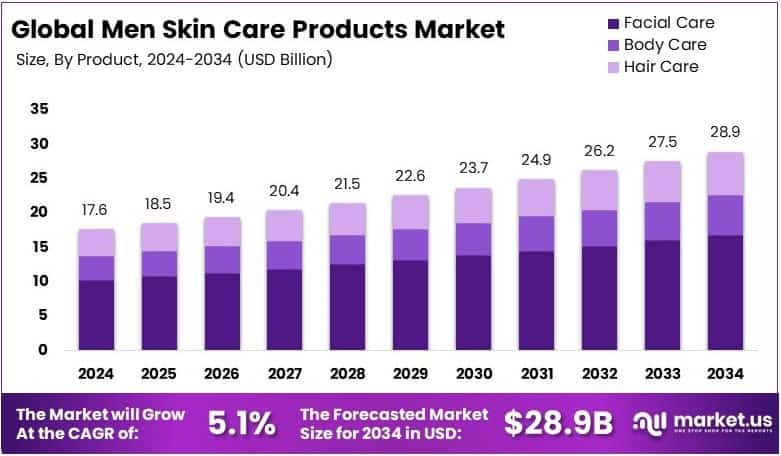Table of Contents
Introduction
The global Men Skin Care Products Market is poised for significant expansion, projected to grow from USD 17.6 billion in 2024 to USD 28.9 billion by 2034, registering a CAGR of 5.1% during the forecast period. The market’s growth is supported by a global cultural shift toward male self-care, expanding product offerings tailored to men’s unique dermatological needs, and rising online retail penetration. Increased awareness regarding grooming, the influence of male celebrities, and demand for natural formulations are reshaping consumer behavior and encouraging new market entrants to innovate.

Key Takeaways
- Men Skin Care Products Market size is forecasted to reach USD 28.9 billion by 2034.
- Facial care products dominate with a 58.2% market share in 2024.
- Oily skin products lead the skin type category with a 39.6% share.
- Organic formulations hold a dominant 64.3% share.
- Online retail accounted for 52.4% of sales in 2024.
- Europe led the market in 2024 with 34.7% share, valued at USD 6.11 billion.
Key Market Segments
- By Product Type: Facial Care, Body Care, Hair Care
- By Skin Type: Oily Skin, Dry Skin, Combination Skin, Sensitive Skin
- By Product Formulation: Organic, Non-organic
- By Distribution Channel: Online Retail, Offline Retail (Specialty Stores, Pharmacies/Drugstores)
Drivers
The men’s skincare market is being driven by evolving social norms around masculinity and grooming. Urban men, particularly millennials and Gen Z, are embracing skincare as part of holistic self-care. Influencer campaigns, celebrity endorsements (e.g., Timothée Chalamet for Chanel), and the launch of male-specific product lines from major brands like L’Oréal and Dove Men+Care further reinforce this shift. Product personalization and innovation—such as oil-control moisturizers and anti-aging serums—are also enhancing consumer interest.
Use Cases
Use cases are expanding across skin conditions and lifestyle preferences. Men with oily skin benefit from targeted formulations using salicylic acid and charcoal. Beard-care and post-shave balms help soothe irritation and maintain healthy skin for grooming-conscious users. Lightweight, non-greasy sunscreens and moisturizers are gaining traction among men who prefer minimal effort but effective results. The growth of subscription boxes also supports routine development, offering curated products for different skin needs.
Major Challenges
Despite rising acceptance, several barriers persist. Traditional stereotypes often hinder male adoption of advanced skincare routines, especially among older demographics. Retail environments still allocate limited shelf space to men’s skincare, reducing visibility and consumer engagement. Additionally, brand loyalty is comparatively lower among male consumers, many of whom opt for convenience over commitment. These factors collectively slow the pace of broader market penetration.
Take advantage of our unbeatable offer - buy now!

Business Opportunities
Significant growth opportunities exist in areas such as personalized skincare regimens powered by AI and skin-analysis tools, D2C models, and sports-specific products tailored for active men. Targeting underserved segments, such as men with sensitive or combination skin, and developing eco-friendly and sustainable lines could unlock new customer bases. Moreover, emerging markets in Asia Pacific, Latin America, and the Middle East present untapped potential due to rising disposable incomes and growing cultural acceptance of grooming.
Regional Analysis
Europe remains the leading region, holding 34.7% of the global market in 2024, owing to a mature grooming culture, premium product demand, and strict safety regulations.
North America follows closely, driven by the influence of celebrity-backed skincare lines and robust online retail infrastructure.
Asia Pacific is witnessing the fastest growth, with nations like South Korea and Japan normalizing male beauty routines through K-beauty trends and localized product development.
Latin America and the Middle East & Africa show promise due to cultural shifts, increased internet penetration, and the influence of Western grooming standards.
Recent Developments
- In January 2025, men’s personal care brand Narh secured seed funding from investor Sandeep Ahuja, marking a significant step in its expansion plans. The funding will be used to scale operations, enhance product offerings, and boost marketing efforts.
- In June 2025, Unilever announced its acquisition of Dr. Squatch, a prominent men’s personal care brand known for its natural products. This strategic move is expected to strengthen Unilever’s portfolio in the male grooming segment across North America.
- In August 2024, Emami Ltd. confirmed its acquisition of a 100% stake in The Man Company, a leading Indian men’s grooming brand. This acquisition will allow Emami to expand its presence in the premium male grooming category and tap into evolving consumer trends.
Conclusion
The global Men Skin Care Products Market is undergoing a transformative phase. With rising demand for effective, natural, and gender-targeted skincare solutions, brands that innovate and engage authentically with male consumers will lead the way. The combination of digital convenience, product diversity, and changing social attitudes presents a promising landscape. Companies that embrace personalization, sustainability, and niche targeting are poised to thrive in this dynamic and evolving market.
Discuss your needs with our analyst
Please share your requirements with more details so our analyst can check if they can solve your problem(s)



